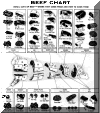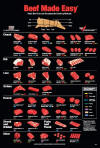Cooking A Suckling Pig
Suckling pigs are usually 10-25 pounds. Allow at least one pound of pork per person. So a 25 lb pig would be the absolute minimum needed for 25 people. A 24-inch barbecue unit will hold a 15 lb pig; a 30-inch unit will hold up to 25 lb. A larger animal will require cooking gear with greater capacity.
If you need to rent a unit, book as far ahead in advance as possible - they get pretty scarce around grilling season.
Pit Roasting a Whole Hog from Ask The Meatman
To Prepare the Pig
Wash pig thoroughly inside and out with cold running water; remove any tissues from cavity. Dry completely inside and out.
Rub body cavity with salt and pepper, and desired seasonings (garlic, thyme, rosemary, etc.).
Fill cavity firmly with a dressing of your choice. Dressing will prevent the sides from collapsing during cooking. Sew up opening with heavy string.
Tie front legs securely so feet are forward near corners of mouth. Tie hind legs securely close to the side of the pig so hind feet nearly touch the fore-legs. Pig should be about 4-inches shorter then the width of the cooking unit.
Prop pig's mouth open with small block of wood or ball of crumpled foil the size of an apple.
Curl tail and cover both the tail and ears with foil.
(Note: Pig roasting requires tender loving care. The chef must be on hand during the barbecuing to keep the fire hot and to check the coals for flare up.)
For Spit Barbecuing - Charcoal Unit
Start fire early. Figure starting time needed by subtracting the hours needed to cook the pig plus one hour from the planned serving time. (Allow 15-20 minutes per pound cooking time).
Use 5 lb. briquettes to start the fire. Coals are ready when they glow and are covered with a white ash. This takes at least 1/2 hour pre-burning. Plan to add about 2-3 lb. briquettes every 1/2 hour to maintain heat.
Mount trussed pig on spit-rod; check balance.
Insert forks securely in pig and tighten.
Insert barbecue meat
thermometer in heaviest part of hind quarter.
Pile hot briquettes for spit barbecuing and extend the coals in a semi-circle where the butt end of the pig will be placed.
Attach spit to unit. Turn on motor.
Place a drip pan (may be made from foil) under pig.
Barbecue pig over medium heat - equivalent to 300 - 375 degrees F (150 - 190 degrees C). You'll be able to hold your hand at the level of the pig for about six seconds. Maintain this heat.
When done, the thermometer should read 160 - 170 degrees F.
Cooking will take 15 - 20 minutes per lb. depending on distance from coals, breeze, and type of cooking unit. A 15 lb. suckling pig takes approximately 4-5 hours.
To test doneness, pierce thickest part of the thigh with a sharp knife. The juice should run a clear yellow.
Reduce heat around head toward end of cooking time. If some parts cook and brown before the rest, wrap with foil, tying on with foil with wire if necessary.
Baste carefully during the last hour of cooking to bronze and crisp the skin. Be careful with a sweet basting sauce, it may caramelize, so reserve basting during the final half hour of cooking time.
Back to Top of Page
Oven Roasting
Place a piece of heavy-duty foil about 12 inches longer than the pig on a rack placed diagonally in a shallow roasting pan.
Brush oil on entire surface of prepared pig.
Place pig on foil; turn the foil up loosely around the pig. If any part of the pig extends beyond the edge of the pan, place double thickness of foil on oven rack to catch any dripping.
Insert meat thermometer in thickest part of thigh.
Pig is done when internal temperature is 160 - 170 degrees F. Approximate cooking time is 20-25 minutes per lb.
Pour the drippings that have collected in the foil into a saucepan. Skim off fat. Reheat and serve as sauce.
To Serve Barbecued or Roast Pig
When pig is done, place on a large platter or baking sheet.
Allow the pig to rest at room temperature for 20 minutes to let juices set and make carving easier.
Remove spit forks and rod, meat thermometer, wooden block/foil ball, trussing strings, and foil covering.
Garnish suggestions: Place small apple in the mouth; insert cranberries or cherries in eye sockets; place parsley in and around ears; drape a garland of greens or fruit around neck; decorate platter with greens and fruit.
To Carve
Bones should separate easily at the joints. First separate shoulder from the body, then remove legs. Cut along the backbone to remove chops from rib and loin area.
Everyone should get a piece of skin to chew on, (it should crackle) and have a rib to gnaw on. The ears and jowls are prized morsels, too.
Back to Top of Page
To Barbecue a Large Pig - Up To 125 lbs.
Wash pig thoroughly inside and out with cold running water; remove any tissues from cavity. Dry completely inside and out.
Stuff pig firmly with dressing.
Stitch ventral cavity closed with strong cord or wire.
Tie front and back legs in position, (forward, and tight to the sides of the pig).
Prop pig's mouth open with a wooden block or foil ball.
Wrap foil over curled tail and ears.
Construct, borrow, or rent a basket-type cooker to hold pig firmly for barbecuing.
Fit pig into lower half of cooker; lower other half down on pig. Fasten securely.
Tie and skewer pig in place so that it won't slip and roll in basket.
The basket-type cooker in then attached to a holder or rack with a motorized pulley wheel that will rotate pig over pit of hot coals. or, arrange to turn manually at regular intervals (every 1/2 hour).
A large pig cooks well if it is scored, rubbed with marinade, and wrapped completely in foil before being place in cooker.
Be prepared with 80-100 lb charcoal briquettes. Start fire with 20 lb briquettes - then add 5 lb. every hour to keep fire hot.
The pig should rotate about 18-inches above hot coals.
COOKING TIME: be sure to allow 1 hour for the fire to get hot. A 125 lb. pig should take at least 6-8 hours to cook.
Check doneness by inserting meat thermometer in thickest part of leg, and also in shoulder meat, near the end of cooking time. Internal temperature should be 160 - 170 degrees F.
To Serve
Place pig on a large table
Remove lacing, twine, and foil wrappings.
Garnish: Replace block in pig's mouth with a apple, put olives in eye sockets, place a fruit garland (cranberries, grapes, orange sections strung together) around neck, if desired.
Allow an hour to cool before carving.
Garnish with presentation table fresh greens.
Remove dressing to large serving bowl.
Carve barbecued pig with sharp carving knife.
You can more information on Pit Roasting a Whole Hog by clicking this link.
Back to Top of Page
Last Updated:
Friday, March 09, 2012 06:09 PM




